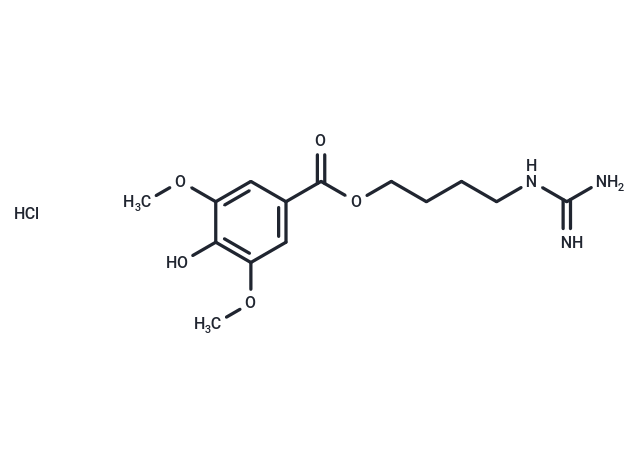Shopping Cart
- Remove All
 Your shopping cart is currently empty
Your shopping cart is currently empty

Leonurine (SCM-198) is an alkaloid that has been found in H. leonuri and with anti-oxidative and anti-inflammatory.

| Pack Size | Price | Availability | Quantity |
|---|---|---|---|
| 5 mg | $31 | In Stock | |
| 10 mg | $48 | In Stock | |
| 25 mg | $98 | In Stock | |
| 50 mg | $147 | In Stock | |
| 100 mg | $215 | In Stock | |
| 500 mg | $536 | In Stock |
| Description | Leonurine (SCM-198) is an alkaloid that has been found in H. leonuri and with anti-oxidative and anti-inflammatory. |
| In vitro | Leonurine significantly inhibited lipid accumulation and promoted 3H-cholesterol efflux in human THP-1 macrophage-derived foam cells in a concentration-dependent manner. Besides, both the mRNA and protein levels of ABCA1/G1, PPARγ and LXRα were enhanced by leonurine, which were attenuated by LXRα siRNA or PPARγ siRNA transfection[1]. |
| In vivo | Administration of leonurine (60 mg/kg) for 4 weeks significantly alleviated depression-like behaviors of chronic mild stress mice, including increased sucrose preference and reduced immobility time in forced swimming test and tail suspension test. We further found that leonurine (60 mg/kg) effectively restored the levels of 5-hydroxytryptamine, noradrenaline, and dopamine in the hippocampus and prefrontal cortex of chronic mild stress mice, accompanied by amelioration of hippocampal neuronal damage. Furthermore, leonurine (60 mg/kg) significantly inhibited the production of proinflammatory cytokine interleukin-1β, interleukin-6 and TNF-α, and suppressed the nuclear factor kappa B signaling pathway[2]. |
| Cell Research | Human THP-1 cells were fully differentiated into foam cells by the pre-treatment with phorbol-12-myristate-13-acetate (PMA) and oxidized density lipoproteins (ox-LDL). After cells were incubated with various concentrations of leonurine, Oil Red O staining and high-performance liquid chromatography (HPLC) assays were utilized to detect cellular lipid accumulation and cholesterol content, respectively. Cellular cholesterol efflux was determined by liquid scintillation counting. The mRNA and protein levels of ATP-binding cassette transporter A1/G1 (ABCA1/G1), peroxisome proliferator-activated receptor γ (PPARγ) and liver X receptor α (LXRα) in foam cells were assessed using real-time quantitative PCR (RT-qPCR) and western blot analyses, respectively. Plasma triglyceride (TG), total cholesterol (TC), high-density lipoprotein-cholesterol (HDL-C) and low-density lipoprotein-cholesterol (LDL-C) levels in apoE-/- mice were evaluated using enzymatic methods. The atherosclerotic lesion sizes and collagen contents in aortic roots were determined by Oil Red O and Masson's trichrome staining, respectively[1]. |
| Animal Research | Used the chronic mild stress mouse model to explore the antidepressant effects of leonurine and the potential mechanisms. Behavioral tests including sucrose preference test, forced swimming test, and tail suspension test were taken to evaluate depression symptoms. Moreover, the contents of monoamine neurotransmitters in hippocampus and prefrontal cortex were measured by high-performance liquid chromatography. Neuronal morphology was detected by transmission electron microscopy[2]. |
| Alias | SCM-198 |
| Molecular Weight | 311.33 |
| Formula | C14H21N3O5 |
| Cas No. | 24697-74-3 |
| Smiles | Cl.COC1=CC(=CC(OC)=C1O)C(=O)OCCCCNC(N)=N |
| Relative Density. | 1.29g/cm3 |
| Storage | Powder: -20°C for 3 years | In solvent: -80°C for 1 year | Shipping with blue ice. |
| Solubility Information | DMSO: < 1 mg/mL (insoluble or slightly soluble) |

Copyright © 2015-2025 TargetMol Chemicals Inc. All Rights Reserved.